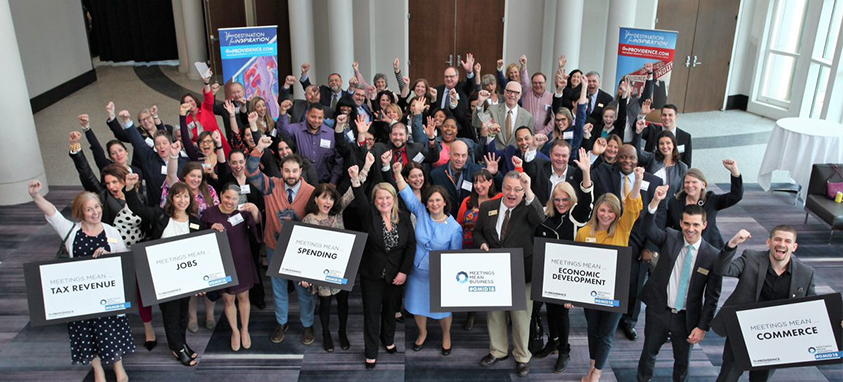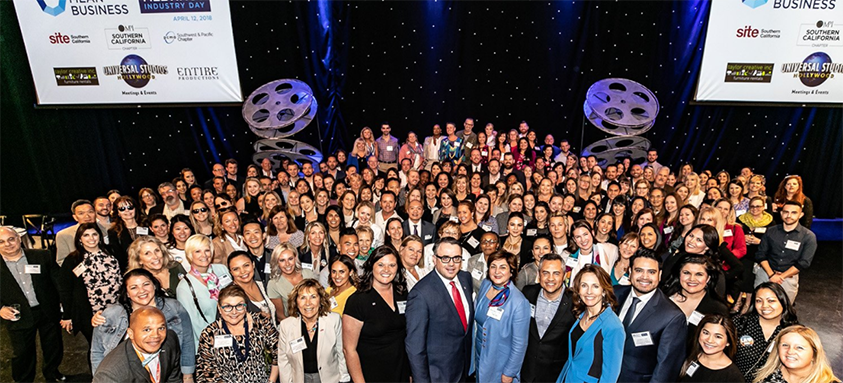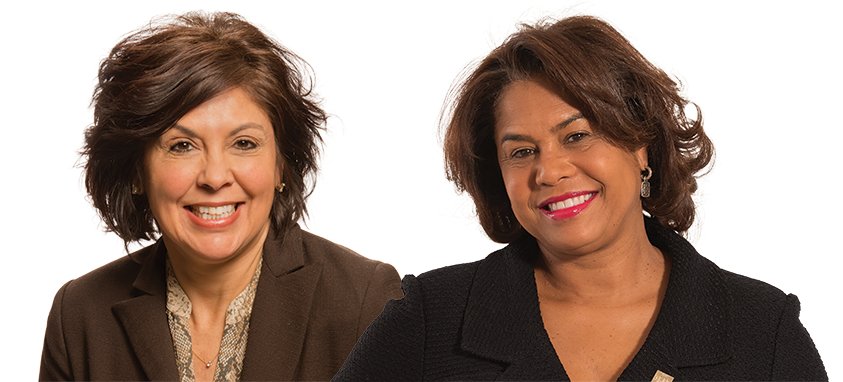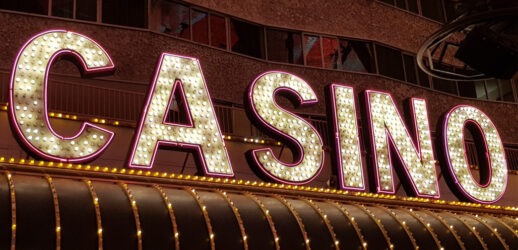Co-chairs reach beyond industry to protect what is important
Pop Quiz: What industry generated more than $1.07 trillion globally in direct spending in 2017? Not the consumer electronics or automotive industries. The economic engine that powers the world is the meetings industry. Yes, revenue from planning, producing, traveling to, attending and hosting meetings, conferences, conventions, exhibitions and incentive travel for some 1.5 billion people from 180 counties was one of the major drivers of economic, business, scientific and social growth over the last few years.
According to a study by Oxford Economics, sponsored by Events Industry Council with support from Meetings Mean Business (MMB), gathering for the purpose of doing business, sharing medical research and rewarding top performers supported 10.3 million direct jobs and generated another $26 million indirectly.
Does That Surprise You?
If the two determined women leading this year’s MMB coalition are successful, the answer to that question will soon be top of mind for people inside and outside the meetings industry—including at the highest levels of government policy-makers. Last August, the organization that brings together event and meeting professionals from all over the world to speak with one voice about the importance of the industry tapped Trina Camacho-London, vice president of Global Group Sales with Hyatt Hotels Corporation, to co-chair awareness efforts alongside a Hyatt alum, Julie Coker Graham, president and CEO of Philadelphia Convention & Visitor’s Bureau, who started her two-year term in 2018.
A Crisis Averted
The 2019 chairs have some pretty big shoes to fill. MMB was born in 2009 as an arm of U.S. Travel Association in the aftermath of President Barack Obama’s comment heard around the world about the boondoggle of meeting in resorts after the government loaned AIG $173 billion as part of the Troubled Assets Relief Program.
The entire industry felt the hit from those remarks, recalls MMB founding co-chair Richard Harper, who now is executive vice president at HelmsBriscoe in Scottsdale, Arizona, but was executive vice president of sales and marketing at MGM Resorts International at the time. “We needed to act, and act quickly, to defend the face-to-face meetings industry,” he says of the first meeting the nascent coalition held in January 2009 in Washington, D.C., with a dozen industry leaders. “We would not be where we are today, with one of the healthiest meetings economy in history, without the efforts of MMB.”
Another co-chair, Larry Luteran, chief sales officer for Encore Event Technologies, who was with Hilton Worldwide when MMB was born, recalls vividly the discussion at an MPI conference in Atlanta in January 2009. “The meetings industry had endured four months of unprecedented attacks, characterizing all meetings as junkets and boondoggles, by people in influential positions that really didn’t understand our business. We were experiencing cancellations of meetings at record levels and the negative rhetoric was out of control,” he says.
Leaders from planning and hospitality organizations took the stage. They proudly declared the meetings and events industry as “the most crucial marketing vehicle available to business, communities and charities.” Armed with data points about the impact on taxes and jobs, they made a rally cry out of the fact that every dollar spent on a meeting or an event had a $12.50 return “That has taught us a valuable lesson—to sustain our energy in communicating the vital role of face to face in the very fabric of our society,” he says.
“The creation of Meetings Mean Business Coalition was quite a feat,” said David Peckinpaugh, president of Maritz Travel, who was part of the effort to organize and later served as co-chair. “It was the first time a true industry coalition was built by bringing together key players with one voice on behalf of the industry.”
Today, MMB is supported by more than 60 member organizations—CVBs, DMOs, international hotel chains, meeting professional associations and event facilitation services—and on one day each April, they all work together to plan a major show of support for the work they do the other 364 days of the year. “Our members may compete away from the table, but they come together to speak with one voice on this topic,” Coker Graham said.
In 2019, Global Meetings Industry Day—GMID—is April 4. Consider this your precon to prepare you to take your role as a promoter, cheerleader and defender of the industry that gives back so much to the world.
A Holistic Approach
Like other chairs before them—Michael Dominguez, senior vice president of corporate sales at MGM Resorts International, and Paul Van Deventer, president and CEO at Meeting Professionals International—Camacho-London and Coker Graham are focused on bringing together all these interests to leverage their collective influence.
The two new co-chairs witnessed the damage of the “boondoggle” comment and resolved to be part of the group coming together to explain why meetings are so important to the global economy, businesses, communities and individuals.
Camacho-London says she can see the difference when a citywide is in town, and a housekeeper can work five days a week instead of three. “It has a ripple effect because she is taking that paycheck home and going to the grocery store and putting her kids through school,” she says.
“The mantra ‘meetings mean business’ really captures it,” Coker Graham says.
The two describe their approach as “holistic” and hope to apply their shared vision of collaborative leadership to move the group forward together. Although both women have packed agendas already, they call the work with MMB “a labor of love.”
“We learn from each other and support each other,” Coker Graham says. “There is nothing greater than working with other smart, intelligent women. We love men, but to be able to co-chair an organization where we have this depth of experience, variety and diversity coming together, and because we know how impactful this industry is for the country and for the world—and to do it as the first female team of this group—is a real opportunity.”
This year’s leadership is hyper-focused on channeling the message of the transformational power of meetings to new audiences. “It is extremely important not to just talk to ourselves. We are all passionate advocates of the industry, but we have to influence those who influence the meetings economy because they can help us if there is some kind of threat,” Coker Graham says. That threat could come in a number of forms, she explains—economic slowdown, security issues, government shutdown—a combination of things that haven’t been considered yet. “We just have to be ready,” she says.
The insurance plan lives on the MMB website in the form of white papers, explainer videos and stories from financial, insurance and tech leaders testifying to the importance of investing in face-to-face opportunities.
The Power of Numbers
Coker Graham explains her role this way: “We have to arm people with the ‘why’ of meetings.” One way to do that is to give them numbers, that is why from the beginning, the group has contracted for robust studies that put hard numbers to the warm feeling people get at the end of a conference.
The Business Leaders Survey in 2015 by APCO Insight found that almost all—99 percent—of financial services, health care, consulting, retail, manufacturing and hospitality senior executives polled believed that in-person meetings helped them succeed. More than 90 percent said they planned to invest more in the coming year in meetings and conferences than they had in the previous year.
A 2018 report by Oxford Economics found that in North America alone, the industry supports 5.9 million jobs and generates an annual economic impact of $845 billion. In fact, North America had the highest direct spend, at $381 billion in 2017, followed by Asia ($290.9 billion), Western Europe ($266 billion), Latin America/Caribbean ($33 billion), Africa ($23.4 billion), Central and Eastern Europe ($23.2 billion) and the Middle East ($1.8 billion).
In terms of the number of business event participants, Asia was the largest market, with 453.4 million, or 31.3 percent, followed by Western Europe (406 million) and North America (329.7 million) in 2017, according to the report.
The share of business events activity accounted for by the top 50 countries (96 percent of the global total) is similar to the 93 percent of global GDP accounted for by those same countries. While the average per-person spend at events was $742, the average in the United States was $1,156, followed by Western Europe ($655) and Asia ($642), according to the study.
“It is important that we show the value of the meetings industry and how it has grown in digestible sound bites so everyone can talk to the same data,” Camacho-London says.
Telling Stories
The importance of face-to-face meetings goes beyond the dollars and cents, however, Coker Graham points out. Real networking and meaningful exchange of ideas can’t be done over the phone or in a text. “The corporate sector has great stories to tell about how they have advanced their businesses and made significant progress,” she says.
That is why the MMB website includes videos of a dozen Fortune 500 business leaders talking about the critical role meetings play in their success. One powerful segment from Celia Fleischaker, chief marketing officer at Epicor, explains how the most important part of a meetings may not be on the agenda at all. At the user conferences they hold each year, the networking, relationship building and sharing of best practices is a valuable element that is difficult to put a price tag on.
Camacho-London knows all too well from working with her geographically dispersed team that when so many people work remotely, the relationships and best practices shared when everyone comes together are at a premium. “It is so impactful and the best way to solve problems and innovate,” she says.
Putting the G in GMID

Although the team believes it has only scratched the surface in increasing awareness in North America, Nan Marchand Beauvois, senior vice president, membership and industry relations; general manager, U.S. Travel Association’s Educational Seminar for Tourism Organizations, says she is seeing interest from geographic areas such as Asia and Africa, where she hasn’t seen interest before. Plus, a newly signed licensing agreement with India will spread the word to this second-most most populous country on the planet.
More: How to Party Like It Is GMID
Meetings Mean Business Canada has been one of the most active chapters, advocating and celebrating the industry and supporting efforts to quantify and communicate the impact on a global scale. Coalition support includes more than 150 businesses of all sizes.
Oxford Economics found that Canada ranked sixth out of the top 50 countries, with $33 billion in direct spend, 229,000 direct jobs and $19.3 billion of direct GDP. Board chair Heidi Welker is also proud to report that according to statistics from Tourism Industry Association of Canada, business travelers are worth four times more than a leisure traveler when it comes to money spent on a trip.
She estimates that business events account for more than 34 percent of all tourism in Canada without knock-on leisure tourism from those who stay over for some quality personal time. “If we included the leisure travel that gets booked around business events, our sector would be about 50 percent of the entire tourism industry in Canada,” she said in a recent note to members.
“Every country has a different reason, but all are using the brand and the rallying cry to move forward,” Marchand Beauvois says.
“To know that Global Meetings Industry Day has grown into a truly global initiative is the most rewarding piece of where we are today,” Dominguez says of the group he co-chaired. “The ability to speak with one voice and one message on the importance of face-to-face engagement and what it means to bring people together is the void that GMID has now filled. As an industry, we are so powerful when we stand together in unity.”
In-Person Meetings are Essential Because—Science
When people come together in person, it activates more parts of the brain than a phone call or web conference ever could. From the frontal lobe (the seat of executive function, such as planning, decision-making and judgement) and occipital lobe (the filter for turning images from the eyes into meaningful information) to the temporal lobe (the home of auditory processing, memory and personality), when we see another person’s face, we make eye contact, detect subtle, nonverbal cues and engage auditory processing by listening to their voices directly, instead of having it filtered through a phone. We are hard-wired to detect faces in the world around us and find significance in them.
Simply put, meeting face to face makes us 91 percent more engaged, 94 percent more collaborative, 88 percent smarter due to improved professional development and 84 percent more productive, according to an MMB survey of business leaders. The conclusion is that professionals stay with the company longer and are more successful at their jobs when they have a chance to connect on a personal level.
Worth Meeting About
In 2016, MMB launched Worth Meeting About to provide the industry with the tool to talk to politicians while they are out in the community campaigning for election. With the 2020 presidential elections looming, the campaign is gearing up to deliver the message that members of all political parties need to hear as they are out meeting door to door at town halls, in diners and on stage.
The campaign encourages people to take to the current president’s favorite platform—Twitter—and send a message about the importance of meetings.
“It was launched to highlight the critical role in-person meetings play during an election year,” says Julie Coker Graham, president and CEO of Philadelphia Convention & Visitor’s Bureau and co-chair of Meetings Mean Business. “It is important to remind policy-makers that when they come together for a national convention, it is a meeting for the purpose of doing the party’s business. It is important to point that out to people who will be addressing travel policies that can impact the ability for others to meet.”
She pledged to continue emphasizing how both parties rely on face-to-face meetings to make decisions and get business done, cast ballots and decide on candidates.
How to Celebrate GMID Like an Advocate

Momentum from the first two Global Meetings Industry Day celebrations has helped spread Meetings Mean Business’ message around the world. This year’s celebrations promise to be even bigger, more diverse and stronger. Last year, 206 events were held in 41 countries. And political leaders have started stepping up. Last year, Canadian Prime Minister Justin Trudeau issued a declaration and attended an event. Chicago Mayor Rahm Emanuel talked at an event in Chicago.
In February, the number of destinations showing interest in participating was 50 percent higher than the same month in 2018, according to Nan Marchand Beauvois, senior vice president, membership and industry relations; general manager, U.S. Travel Association’s Educational Seminar for Tourism Organizations.
MMB Co-chair Julie Coker Graham observes that the nearness of the 2020 elections is making the event attractive to candidates. In Philadelphia, Jim Keaney is scheduled to attend, and the agenda tackles difficult social topics, such as the opioid crisis and how that is impacting homelessness and panhandling. “The meetings industry can help combat this epidemic. We are talking about serious topics,” she says.
How will you celebrate on April 4? Tweet us @smartmeetings and tag #GMID19.





